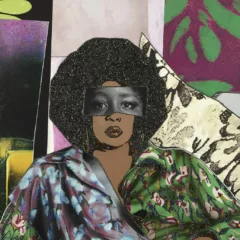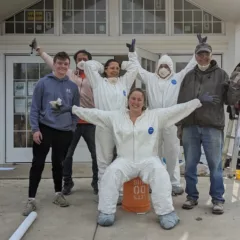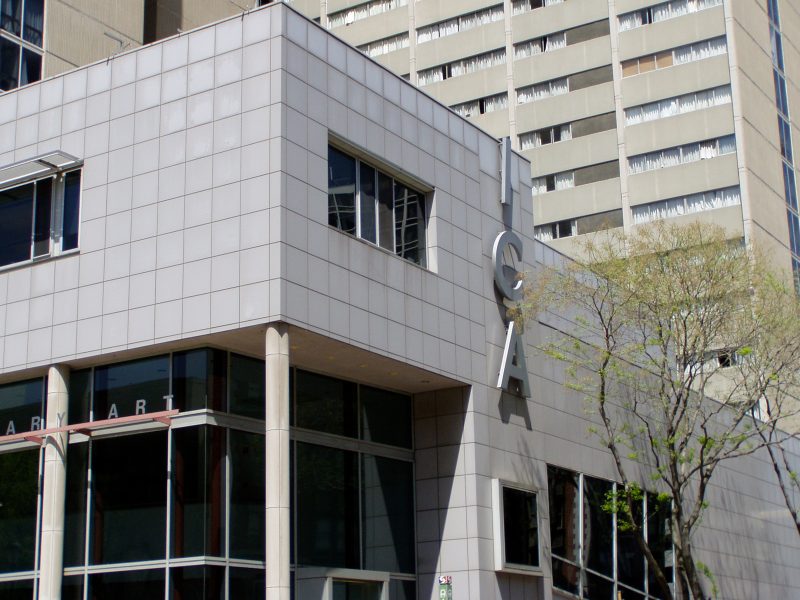
Museums have always been sites whose purpose is given to change. From their inception as high-society beacons of discovery and elite culture, to the more contemporary idea of museums as places of learning and community, cultural sites are uniquely positioned to respond to their surrounding constituencies. At the core of the flexibility of museums lies the question of purpose: What should museums do and be? Are they here to support the learning of the general public, preserve artifacts and artworks for posterity, make everyone welcome, or only a select few? Institutions have grappled with these questions for as long as they have existed, and recent global events are putting institutions in the hot seat with a new variation on the theme: what is a museum in the age of social distancing? Our newest iteration of “museum” seems to look something like a well-stocked social media page or some high-resolution images on a website. But what about the communal side of things: how can institutions serve and connect with the public, when people are avoiding going in public?
In recent weeks I have seen this reevaluation first hand. As the Program Coordinator at the Institute of Contemporary Art, it is (normally) my job to actualize events that make the public feel welcome at UPenn’s contemporary art museum. From organizing student programs, to conducting ASL-interpreted tours, ICA runs the gamut of public engagement. So, what does my job become when the physical museum is indefinitely out of commission? (Answer: I am learning all about digital engagement!)
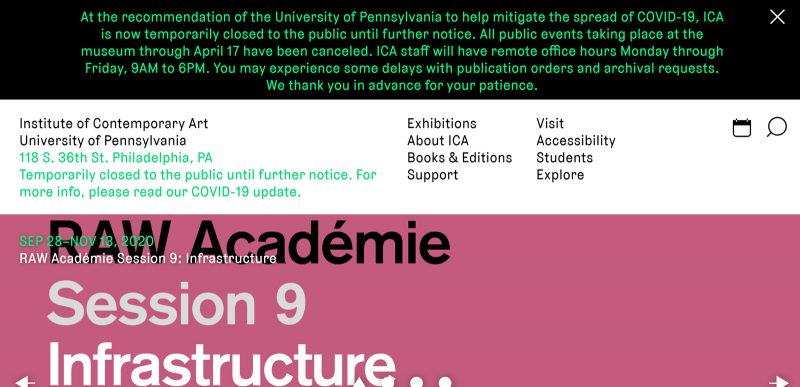
This is the question that museum staffers, freelancers, and volunteers are asking themselves all across the country, and around the world. On a global scale, institutions are facing tough questions of capacity and budget as work moves off-site for an unknown period. For some places, these questions are leading to life-changing decisions for their staff. For example, Mass MoCA recently announced that they are laying off 75% of staff in the wake of this global health crisis.* The Los Angeles Museum of Contemporary Art is close behind, having cut around 50% of their workforce. The Guggenheim and Whitney have also cut almost 100 staffers each. The human impact is immense, though of course these widespread labor changes are not unique to the cultural sector.
At the onset of COVID-19, many institutions nationally and globally began by pulling back on programs, or halting them altogether. As the situation worsened, institutions shuttered, some advertising reopening dates, others not. Many museums now have closure and health statements on their website, some of these places are able to offer alternative engagement ideas, others seem to have gone quiet. The Philadelphia Museum of Art, for example, directs people to their social media pages for engagement opportunities. The Barnes Foundation has been giving staff members the opportunity to pick objects that they connect to–some staffers even suggest work from home tips alongside their selections. Other organizations and institutions are offering web series, such as the Kennedy Center’s adorable “Lunch Doodles with Mo Willems.” These initiatives–from social media engagement to online streams of panels–are all ways that institutions hope to keep the public’s attention, as well as support individuals who need a distraction from the terrifying daily news cycle. Our very own Artblog has also found ways to support the community, offering an incredible series called “Artists in the Time of Coronavirus,” which gives local artists a chance to share their struggles and connect. Other individuals too are taking it upon themselves to not lose artmaking and creative engagement at this time (it is proven, after all, that arts are good for your health)**.
Of course, these changes to how a museum functions must come from the staff of those very sites. As with the rest of the world, museum workers–many of whom are used to a hybrid gallery/office setting–are adjusting to life on the couch or at the kitchen table. People who have spent their lives working with objects or with the public are relearning how to engage without having people or places to facilitate that engagement. These changes, combined with the constant unease of being a cultural laborer at a time when (rightfully so) attention is shifting to health, economics, and international relations, make for a lot of reassessment. How can–how should–museums serve the public, while keeping an eye on their own well-being? At ICA, and I can only assume at our sister institutions, this question is the constant talk of Zoom and phone meetings.
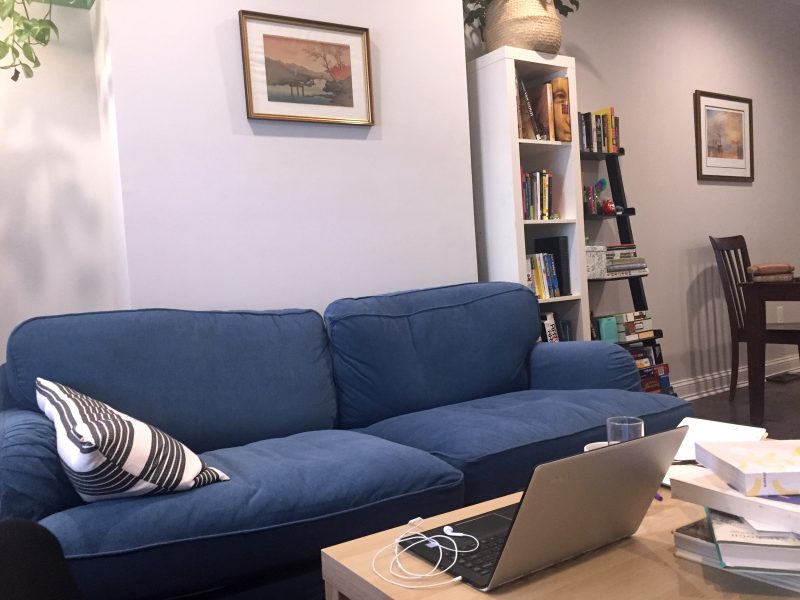
In times of crisis, individuals often turn to the arts as a respite or a way to heal. Viral links have surfaced of individuals in Italy coming together and singing from the rooftops, or of people stuck at home recreating canonical paintings. In my own West Philadelphia neighborhood, a marching band has been spotted weaving through the streets. While the museum junkie inside of me cheers at the myriad of resources becoming available to individuals with an internet connection, another part of me feels lost. When I check out virtual tours of places like the Uffizi Gallery, I am floored at the opportunity to see this space, but my isolation is also drawn into sharp relief. Am I soothed? Kind of. (I’m not alone in this line of thinking, I promise.)
The things that are really making me feel connected are not the virtual tours, but the human side of shutdown. I was once told by a very wise colleague that much of working in a museum is about making yourself invisible. If we are successful, shows come and go with ease, programs start on time and proceed without a hitch, labels answer questions, and people see the art without distraction. Now, more than ever, I am struggling with what that (in)visibility means: even as news consistently breaks about staffers being laid off in droves, bringing cultural labor to the public spotlight, websites are (thankfully) seamlessly updated and digital programs flow on. All the while, some of the most invisible workers – not the curators in charge or the educators on the floor, but the folks behind the scenes – have come to the fore. Take Tim, for example: the head of security at the National Cowboy Museum, who has charmingly taken over the institution’s Twitter and brought such joy and realness to their objects. Sure, the images Tim shares are not nearly the quality of those produced by a Google-hosted virtual tour, but I get the soul of the space from his narrative.
Hello, my name is Tim and I am the head of security for The Cowboy. I have been asked to take on the additional duty of social media management while the museum is closed. I’m new to this but excited. My team will also continue to protect and monitor the museum. Thanks, Tim Send pic.twitter.com/bPiXD9DoAd
— Nat'l Cowboy Museum (@ncwhm) March 17, 2020
Still, all of these variations on digital engagement–from social media to streaming–require staff for their execution. In addition to Mass MoCA and the Guggenheim, the Hammer, the Cleveland Museum of Art, and the Carnegie Museum have also conducted layoffs. The Met has said it will pay its workers until a certain date, and will then need to reassess. As museums recalibrate to think about online engagement, who will be performing this labor? As I watch friends and colleagues be put in tougher and tougher situations, learning skills that they never would have thought they’d need, I feel ever more grateful at the way my institution is trying to care for its workers through things like internal mindfulness sessions and check-ins. I am also aware of the unique position of being part of a free, University-adjacent institution, that does not rely on admission fees for revenue. I wonder: how can museums not only support our publics, but each other?
As the remaining employed cultural workers do our best to reach out, we need to consider the purpose and effectiveness of our extended arms. As I sit on my couch and buzz through art videos on YouTube, lectures on museums’ websites, or tours on Google, I wonder at who these are for, and what viewers are expected to get from them. My ability, internet connection–even my time–are often presupposed. It is a great privilege for institutions to be producing content with the idea of bringing people together, even as people have been asked to be physically separate in a way many of us never have been before. Are people watching? Is the work that cultural laborers are doing even being received? I think the answer is yes. For example, last week I was thrilled to see an ICA digital program match the attendance of its “normal” physical counterpart pre-COVID – a sign that, to me, shows that our efforts are working. We – museums and their cultural workers – are indeed serving a need. Even if people only absorb half the content, we continue to watch the videos, read the letters from the directors, and scan social media for our favorite works of art.
At the root of things, I believe that art remains a great human connector. Even though not every digital engagement strategy will work, I am glad that museums are still trying, and I dearly hope that when this passes institutions will realize the necessity of their staff and begin the re-hiring process. Every day I am reminded that I am still in a functional arts job, and am very very lucky. As I reach out to my peers, I remain hopeful that the creative community will survive the economic hit, and use this time to work, write, make, and connect as best we can, so that when this is all over, we have a record, and can come together in new and stronger ways. Tweets, Facebook threads, Instagram posts (#museumfromhome), artwork made in your living room, writing done, YouTube videos watched on repeat or only halfway through–all of it is a part of the digital sphere of the arts right now, each piece valuable in keeping us all sane, and visible, even if not fully satisfied.

**https://www.medicalnewstoday.com/articles/320947#Improved-mental-health
Additional home engagement resources:
https://fabricworkshopandmuseum.org/event/fwm-home-quarantine-prints-home-art-exercises/
https://www.theartnewspaper.com/feature/artful-resources-to-keep-kids-entertained-at-home
https://news.artnet.com/art-world/virtual-art-experiences-1809261
https://www.travelandleisure.com/attractions/museums-galleries/museums-with-virtual-tours
https://artsandculture.google.com/streetview/metropolitan-museum-of-art/KAFHmsOTE-4Xyw?sv_lng=-73.9624786&sv_lat=40.7803959&sv_h=342.9&sv_p=0&sv_pid=KeFx8oXHzeuY8L5rfepHaA&sv_z=1
https://news.artnet.com/art-world/favorite-museum-youtube-videos-1810353
https://hyperallergic.com/547919/2500-virtual-museum-tours-google-arts-culture/
https://www.washingtonpost.com/entertainment/museums/so-youre-stuck-at-home-heres-a-guide-to-finding-great-art-while-in-isolation/2020/03/18/ccacd222-67c0-11ea-9923-57073adce27c_story.html



